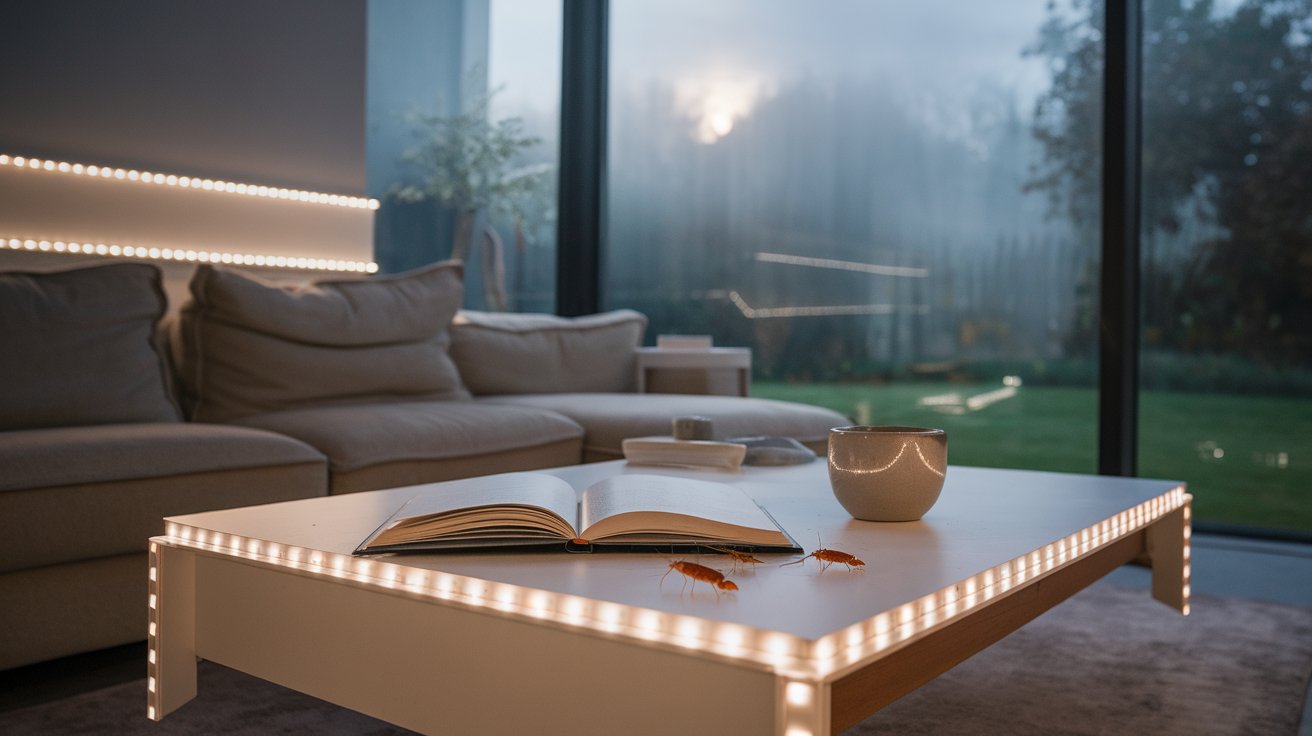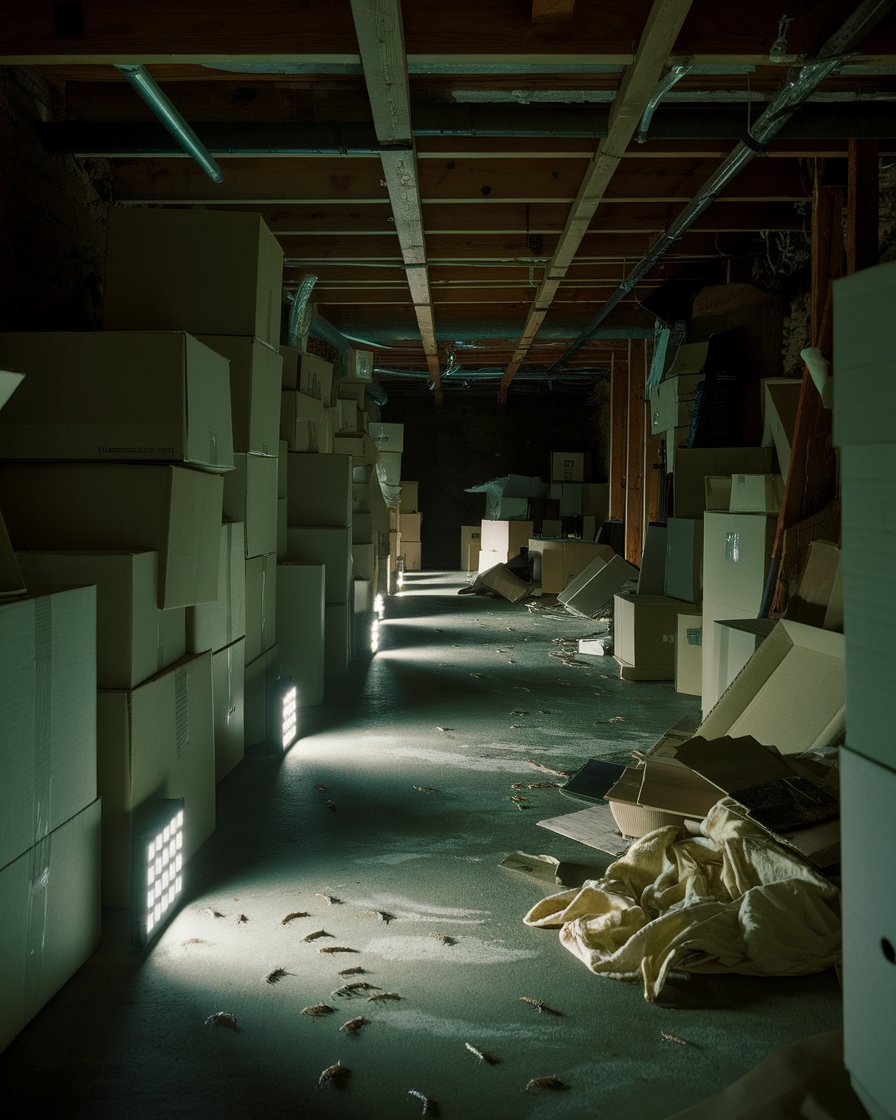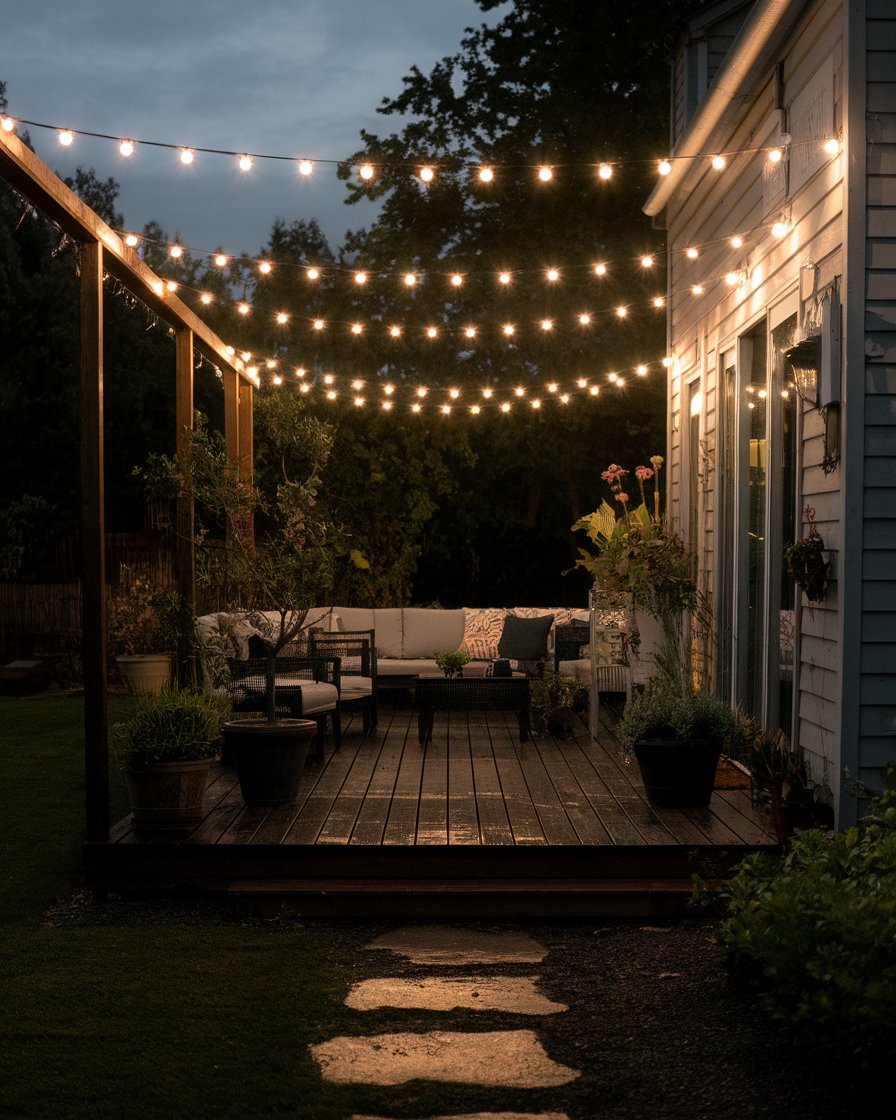Introduction
Silverfish are small insects that are often found in homes with high humidity. These wingless pests thrive in dark, damp environments and are primarily attracted to areas where they can access food sources like paper, glue, and fabrics. Silverfish prefer to eat materials rich in starch, which is why basements, bathrooms, and kitchens are common hiding places. While it’s easy to assume that light sources like LED lights may play a role in drawing them out, silverfish are primarily attracted to dark spaces, making them less likely to be found near illuminated areas. Preventing silverfish infestations requires careful attention to moisture levels and food storage.
LED lights and silverfish attraction have sparked some misconceptions. Contrary to popular belief, silverfish are not drawn to light, particularly LED lights. Instead, they thrive in environments with minimal light exposure. Sealing cracks and using sealed containers to prevent silverfish from accessing food are important steps to reduce the likelihood of an infestation. Keeping your home well-lit in areas where silverfish are present, combined with reducing moisture, can help make your home less appealing to these pests.
Key Takeaways
-
Silverfish are primarily attracted to dark, humid environments where they can find food sources like paper, glue, and fabrics.
-
Despite common misconceptions, silverfish are not attracted to LED lights and instead avoid well-lit areas.
-
Sealing cracks and using airtight containers for food storage are effective ways to prevent silverfish infestations.
-
LED lights do not emit enough UV light to attract silverfish, making them a less appealing environment for these pests.
-
Maintaining a clean, dry home with proper ventilation can significantly reduce the likelihood of silverfish infestations.
-
Natural remedies such as diatomaceous earth and essential oils like lavender can help keep silverfish at bay.
Factors that Attract Silverfish
Silverfish are small, wingless insects that often find their way into homes, particularly those with high humidity levels. They are primarily attracted to environments that offer ample food and water sources. The diet of silverfish includes materials rich in starch, such as paper, glue, and fabrics like cotton and linen. Their attraction to moisture makes them likely to inhabit bathrooms, basements, and kitchens. Silverfish are also known to thrive in dark and warm areas, making your home an ideal environment if these conditions are present. Preventing silverfish from entering your home requires eliminating these favorable conditions and sealing cracks or gaps where they can enter.
Common Misconceptions About Silverfish and LED Lights
1. Silverfish Are Not Attracted to LED Lights
Despite popular belief, silverfish are not attracted to LED lights. These pests thrive in dark, humid environments and actively avoid well-lit areas. LED lights produce minimal UV light, which is the main type of light that typically attracts insects. As a result, LED lights have no influence in attracting silverfish. It is important to understand this distinction to prevent unnecessary lighting adjustments aimed at controlling silverfish.
2. Silverfish Thrive in Moist, Dark Areas
Silverfish primarily seek out areas with high humidity and minimal light exposure. Bathrooms, basements, and attics are ideal hiding spots, especially in homes where moisture levels are not well-regulated. Even though LED lights may reduce other insects’ presence, silverfish will continue to thrive in dark, damp places unless moisture and food sources are controlled.
3. Moisture Management is Key to Silverfish Control
The key to preventing silverfish infestations lies in managing the moisture in your home. Silverfish are drawn to moist environments, not light sources. Using dehumidifiers, fixing leaks, and ensuring proper ventilation in humid areas are more effective than simply adjusting lighting. LED lights may not attract silverfish, but moisture reduction can significantly decrease their presence.
4. Seal Entry Points to Prevent Silverfish Infestations
Although LED lights do not repel silverfish, sealing cracks and crevices where these pests can enter is a crucial preventive measure. Silverfish tend to invade homes through tiny openings in walls, floors, and foundations. Proper home maintenance, such as caulking and sealing, will prevent silverfish from entering, regardless of the type of lighting used.
5. LED Lights Are Less Likely to Attract Other Pests
While LED lights may not have any impact on silverfish, they are beneficial in reducing the attraction of other common household pests like flies and moths. Traditional light bulbs emit UV light, which attracts these pests. Switching to LED lights reduces the overall number of insects in your home, which in turn can help reduce food sources for silverfish.
The Need for Food and Water
Silverfish are drawn to homes where they can find food sources rich in carbohydrates and proteins. Common items they consume include paper, book bindings, and natural fibers such as wool or silk. Since silverfish are attracted to moisture, they often seek out damp locations like bathrooms, basements, or laundry rooms. Airtight containers can help prevent silverfish from accessing food, reducing the risk of infestations. Reducing humidity levels and promptly cleaning up spills can also make your home less appealing to these pests, making it harder for them to thrive.
Preferred Environments for Silverfish
Silverfish thrive in dark and humid areas where they can easily find both food and shelter. While some might think silverfish are attracted to LED lights, this is not the case. Silverfish prefer dark environments and only wander into well-lit areas when searching for food. It is essential to keep areas like basements, attics, and closets dry to deter these pests from settling in. Using dehumidifiers and sealing food in airtight containers can effectively minimize the chances of a silverfish infestation. Keeping your home dry and clean is key to preventing silverfish from entering your space.
The Relationship Between Light and Silverfish
Silverfish are primarily known for thriving in dark, humid environments, making them quite different from other insects often drawn to light. Many people wonder if silverfish are attracted to lights, especially LED lights, but scientific evidence shows that silverfish do not seek out well-lit areas. Instead, they prefer to inhabit places where light is minimal, such as basements, bathrooms, or behind furniture. Areas where silverfish are likely to be found are usually those that are damp and offer plenty of hiding spots. Therefore, keeping your home well-lit may not necessarily deter them, but understanding their aversion to light can help you better control their presence in your home.
Case Study: The Effectiveness of LED Lights in Reducing Silverfish Presence
In a study conducted by a pest control company in 2020, researchers sought to evaluate whether LED lights had any effect on silverfish activity within homes. The study involved two identical home environments—one illuminated primarily by LED lights and the other by traditional incandescent bulbs. Both homes had areas known for attracting silverfish, such as basements and bathrooms. Over a period of four months, it was observed that silverfish activity remained constant in both environments, with no significant difference in the number of silverfish found in either home.
This case study confirmed that silverfish are not attracted to LED lights or traditional bulbs. Instead, their primary motivation for inhabiting a space is access to moisture and food sources, such as paper or fabrics. The findings support the claim that LED lights do not deter or attract silverfish, solidifying the need to focus on moisture control rather than lighting.
Types of Lights That Attract Insects
While many insects, such as moths, flies, and mosquitoes, are attracted to light sources due to their phototactic nature, silverfish behave differently. Bugs are typically drawn to UV light, which is emitted by many traditional bulbs. However, LED lights produce minimal UV light, making them less appealing to most insects. Silverfish, on the other hand, are not attracted to any light, whether it be natural or artificial. These pests prefer dark, secluded areas where they can avoid being exposed. This key difference is why using LED lights does not prevent silverfish from entering your home, but it can reduce the presence of other bugs.
Scientific Explanation for Silverfish Aversion to LED Lights
Silverfish have a natural aversion to light, especially the wavelengths emitted by LED lights. Unlike insects that navigate or are drawn to lights, silverfish avoid them at all costs. They thrive in dark, damp environments, and exposure to light disrupts their nocturnal behaviors. While some might suggest that LED lights attract silverfish, this claim has been debunked. LED lights do not attract silverfish because they emit a low amount of UV light, and silverfish are biologically predisposed to seek shelter in areas without any light. To get rid of silverfish in your home, focus on reducing humidity and sealing off areas where silverfish may find refuge.
LED Lights as a Deterrent
LED lights are commonly known for their energy efficiency, but they also offer an unexpected benefit: deterring pests like silverfish. These small, wingless insects thrive in dark, humid environments and avoid brightly lit spaces. While many bugs are attracted to light sources, silverfish have a natural aversion to it, especially the wavelengths of light emitted by LED bulbs. This makes LED lights a practical tool in preventing silverfish infestations. Placing LED lights in dark, damp areas of your home can help discourage these pests from settling. Additionally, since LED lights emit minimal heat, they won’t inadvertently attract other bugs while serving their purpose as a deterrent for silverfish.
Impact of LED Lights on Silverfish Behavior
Silverfish are nocturnal creatures that actively seek out dark, humid places to live. LED lights disrupt this behavior by making areas they would typically inhabit less appealing. The wavelengths of light produced by LEDs interfere with the silverfish’s natural instinct to seek shelter in dark spaces. Homeowners can strategically place LED strip lighting in areas where silverfish are likely to hide, such as basements, closets, and under sinks. By using LED lights in these areas, you can reduce the chances of silverfish settling in your home. Additionally, LED lights do not emit much heat, further reducing the risk of attracting other insects while keeping silverfish at bay.
Benefits of Using LED Lights to Repel Silverfish
Aside from their energy efficiency, LED lights offer significant advantages when it comes to pest control, specifically deterring silverfish. Their minimal heat output ensures they won’t attract bugs that are typically drawn to warmth, making them a safe and effective option. When placed in dark spaces where silverfish thrive, these lights can reduce the likelihood of an infestation. Homeowners looking to keep silverfish away should focus on illuminating areas where these pests are likely to hide, like attics or basements. Combined with other preventive measures, such as sealing cracks and using airtight containers to store food, LED lighting can significantly reduce the risk of silverfish in your home.
“Light is the first element of design; without it there is no color, form, or texture.” – Thomas E. Farin
Tips for Preventing Silverfish Infestations
Silverfish infestations can be a persistent problem, especially in homes with high humidity and dark spaces. However, with the right preventive measures, you can minimize the chances of these pests invading your space. Silverfish are drawn to areas that offer food sources like paper, fabric, and other materials rich in starch. Additionally, they thrive in humid environments such as basements, bathrooms, and attics. To keep silverfish out of your home, it’s essential to reduce these attractive conditions. Maintaining a clean, dry space and sealing any potential entry points will significantly lower the risk of silverfish infestations.
Home Maintenance Practices
Homeowners can effectively reduce the risk of silverfish infestations by following some basic maintenance practices. Regularly vacuuming areas where silverfish are likely to hide, such as attics and basements, helps eliminate their food sources, including dust, paper, and fabric. Sealing cracks in walls and baseboards will also prevent silverfish from entering your home. Ensuring proper ventilation in areas with high humidity, like bathrooms and kitchens, is key to reducing moisture levels, which silverfish are attracted to. By paying attention to these details and keeping a clean home, you can make your space less appealing to these pests.
Natural Remedies to Keep Silverfish at Bay
In addition to routine cleaning, natural remedies can help repel silverfish. Diatomaceous earth, a natural powder, can be sprinkled around areas where silverfish are likely to enter, creating a barrier that deters them. Essential oils, such as lavender and cedarwood, are also effective in keeping silverfish away. Mixing these oils with water and spraying them in affected areas provides a natural solution without the use of harsh chemicals. For added protection, store food items like cereals and grains in airtight containers to prevent silverfish from accessing their food sources. Combining these natural remedies with regular maintenance will reduce the risk of silverfish infestations in your home.
Conclusion
In conclusion, silverfish thrive in environments that are dark and damp, particularly areas inside the home like basements, attics, and bathrooms. Although many insects are attracted to light, silverfish are not drawn to LED lights, contrary to popular belief. Instead, they avoid illuminated spaces, preferring to hide in darker areas where moisture is prevalent. Maintaining a dry, well-ventilated home and using airtight containers for food storage are essential steps in preventing these pests from entering your home.
While LED lights do not repel silverfish directly, they make certain areas less appealing by reducing the ideal dark conditions silverfish love. Additionally, sealing cracks around your home and placing diatomaceous earth in key areas can deter these pests from settling. Preventing silverfish infestations requires a combination of reducing moisture, ensuring proper lighting in areas where they hide, and maintaining cleanliness. By staying vigilant, you can successfully keep silverfish out of your home.














